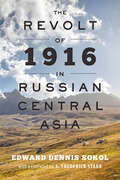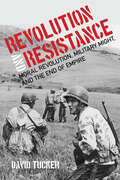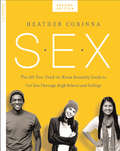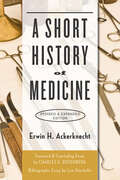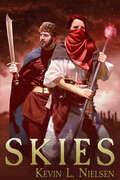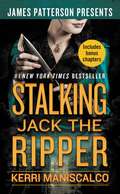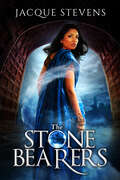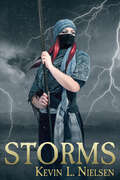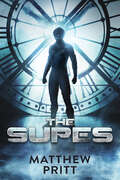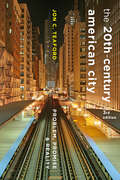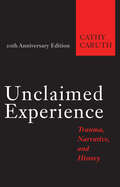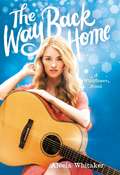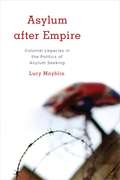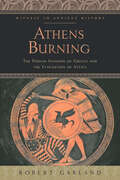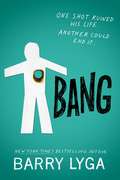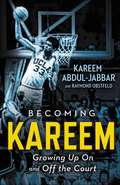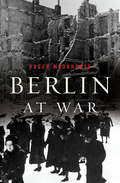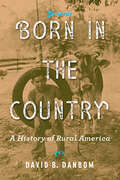- Table View
- List View
The Revolt of 1916 in Russian Central Asia (The Johns Hopkins University Studies in Historical and Political Science #71)
by Edward Dennis SokolDuring the summer of 1916, approximately 270,000 Central Asians;¢;‚¬;€?Kazakhs, Kyrgyz, Tajiks, Turkmen, and Uzbeks;¢;‚¬;€?perished at the hands of the Russian army in a revolt that began with resistance to the Tsar;€™s World War I draft. In addition to those killed outright, tens of thousands of men, women, and children died while trying to escape over treacherous mountain passes into China. Experts calculate that the Kyrgyz, who suffered most heavily, lost 40% of their total population. This horrific incident was nearly lost to history. During the Soviet era, the massacre of 1916 became a taboo subject, hidden in sealed archives and banished from history books. Edward Dennis Sokol;€™s pioneering Revolt of 1916 in Russian Central Asia, published in 1954 and reissued now for the first time in decades, was for generations the only scholarly study of the massacre in any language. Drawing on early Soviet periodicals, including Krasnyi Arkhiv (The Red Archive), Sokol;€™s wide-ranging and exhaustively researched work explores the Tsarist policies that led to Russian encroachment against the land and rights of the indigenous Central Asian people. It describes the corruption that permeated Russian colonial rule and argues that the uprising was no mere draft riot, but a revolt against Tsarist colonialism in all its dimensions: economic, political, religious, and national. Sokol;€™s masterpiece also traces the chain reaction between the uprising, the collapse of Tsarism, and the Bolshevik Revolution. A classic study of a vanished world, Sokol's work takes on contemporary resonance in light of Vladimir Putin;€™s heavy-handed efforts to persuade Kyrgyzstan to join his new economic union. Sokol explains how;‚ an earlier Russian conquest ended in;‚ disaster and;‚ implies that a;‚ modern;‚ conquest might have the same effect. Essential reading for historians, political scientists, and policymakers, this reissued edition is being published to coincide with the centennial observation of the genocide.
The Revolt of 1916 in Russian Central Asia (The Johns Hopkins University Studies in Historical and Political Science #71)
by Edward Dennis SokolDuring the summer of 1916, approximately 270,000 Central Asians;¢;‚¬;€?Kazakhs, Kyrgyz, Tajiks, Turkmen, and Uzbeks;¢;‚¬;€?perished at the hands of the Russian army in a revolt that began with resistance to the Tsar;€™s World War I draft. In addition to those killed outright, tens of thousands of men, women, and children died while trying to escape over treacherous mountain passes into China. Experts calculate that the Kyrgyz, who suffered most heavily, lost 40% of their total population. This horrific incident was nearly lost to history. During the Soviet era, the massacre of 1916 became a taboo subject, hidden in sealed archives and banished from history books. Edward Dennis Sokol;€™s pioneering Revolt of 1916 in Russian Central Asia, published in 1954 and reissued now for the first time in decades, was for generations the only scholarly study of the massacre in any language. Drawing on early Soviet periodicals, including Krasnyi Arkhiv (The Red Archive), Sokol;€™s wide-ranging and exhaustively researched work explores the Tsarist policies that led to Russian encroachment against the land and rights of the indigenous Central Asian people. It describes the corruption that permeated Russian colonial rule and argues that the uprising was no mere draft riot, but a revolt against Tsarist colonialism in all its dimensions: economic, political, religious, and national. Sokol;€™s masterpiece also traces the chain reaction between the uprising, the collapse of Tsarism, and the Bolshevik Revolution. A classic study of a vanished world, Sokol's work takes on contemporary resonance in light of Vladimir Putin;€™s heavy-handed efforts to persuade Kyrgyzstan to join his new economic union. Sokol explains how;‚ an earlier Russian conquest ended in;‚ disaster and;‚ implies that a;‚ modern;‚ conquest might have the same effect. Essential reading for historians, political scientists, and policymakers, this reissued edition is being published to coincide with the centennial observation of the genocide.
Revolution and Resistance: Moral Revolution, Military Might, and the End of Empire
by David TuckerIn this provocative history, David Tucker argues that "irregular warfare";¢;‚¬;€?including terrorism, guerrilla warfare, and other insurgency tactics;¢;‚¬;€?is intimately linked to the rise and decline of Euro-American empire around the globe. Tracing the evolution of resistance warfare from the age of the conquistadors through the United States;€™ recent ventures in Afghanistan and Iraq, Revolution and Resistance demonstrates that contemporary conflicts in the Middle East, Africa, and Asia are simply the final stages in the unraveling of Euro-American imperialism. Tucker explores why it was so difficult for indigenous people and states to resist imperial power, which possessed superior military technology and was driven by a curious moral imperative to conquer. He also explains how native populations eventually learned to fight back by successfully combining guerrilla warfare with political warfare. By exploiting certain Euro-American weaknesses;¢;‚¬;€?above all, the instability created by the fading rationale for empire;¢;‚¬;€?insurgents were able to subvert imperialism by using its own ideologies against it. Tucker also examines how the development of free trade and world finance began to undermine the need for direct political control of foreign territory.Touching on Pontiac;€™s Rebellion of 1763, Abd el-Kader;€™s jihad in nineteenth-century Algeria, the national liberation movements that arose in twentieth-century Palestine, Vietnam, and Ireland, and contemporary terrorist activity, Revolution and Resistance shows how changing means have been used to wage the same struggle. Emphasizing moral rather than economic or technological explanations for the rise and fall of Euro-American imperialism, this concise, comprehensive book is required reading for anyone seeking to understand the character of contemporary conflict.
Revolution and Resistance: Moral Revolution, Military Might, and the End of Empire
by David TuckerIn this provocative history, David Tucker argues that "irregular warfare";¢;‚¬;€?including terrorism, guerrilla warfare, and other insurgency tactics;¢;‚¬;€?is intimately linked to the rise and decline of Euro-American empire around the globe. Tracing the evolution of resistance warfare from the age of the conquistadors through the United States;€™ recent ventures in Afghanistan and Iraq, Revolution and Resistance demonstrates that contemporary conflicts in the Middle East, Africa, and Asia are simply the final stages in the unraveling of Euro-American imperialism. Tucker explores why it was so difficult for indigenous people and states to resist imperial power, which possessed superior military technology and was driven by a curious moral imperative to conquer. He also explains how native populations eventually learned to fight back by successfully combining guerrilla warfare with political warfare. By exploiting certain Euro-American weaknesses;¢;‚¬;€?above all, the instability created by the fading rationale for empire;¢;‚¬;€?insurgents were able to subvert imperialism by using its own ideologies against it. Tucker also examines how the development of free trade and world finance began to undermine the need for direct political control of foreign territory.Touching on Pontiac;€™s Rebellion of 1763, Abd el-Kader;€™s jihad in nineteenth-century Algeria, the national liberation movements that arose in twentieth-century Palestine, Vietnam, and Ireland, and contemporary terrorist activity, Revolution and Resistance shows how changing means have been used to wage the same struggle. Emphasizing moral rather than economic or technological explanations for the rise and fall of Euro-American imperialism, this concise, comprehensive book is required reading for anyone seeking to understand the character of contemporary conflict.
S.E.X., second edition: The All-You-Need-To-Know Sexuality Guide to Get You Through Your Teens and Twenties
by Heather CorinnaThe go-to sex ed guide for teens and young adults, tackling everything you want to know about sex, from consent, safe sex, emotional health and more, from the founder of scarleteen.com.As a teen or emerging adult, dealing with all the changes going on in your life, body, and mind can be mighty overwhelming. When it comes to sex, everyone seems to have strong feelings and opinions about who you should be and what you should (shouldn't) do. How do you decide who to listen to? Heather Corinna and Scarleteen have provided sex education and information to millions of young people, parents, and mentors since 1998; S.E.X. tackles all the big topics:Self-image and how to find and claim your own sexual selfHow to best protect and support your sexual and emotional healthSorting out gender and sexual identities, even when they're complicated and confusingThe latest on contraceptive methods and other reproductive choices, sexually transmitted infections, and safer sexFinding, creating, and managing healthy and happy relationshipsHow to set and respect limits and boundaries, and rock consentIdentifying, preventing, or healing from abuse or assault...and much more.Whatever your gender or sexual identity, whether you've already been actively exploring your sexuality or are only just getting curious, S.E.X clearly spells out what you need and want to know--no shame, no judgement, just comprehensive and accurate info in a clear, straightforward language.
S.E.X., second edition: The All-You-Need-To-Know Sexuality Guide to Get You Through Your Teens and Twenties
by Heather CorinnaThe go-to sex ed guide for teens and young adults, tackling everything you want to know about sex, from consent, safe sex, emotional health and more, from the founder of scarleteen.com. As a teen or emerging adult, dealing with all the changes going on in your life, body, and mind can be mighty overwhelming. When it comes to sex, everyone seems to have strong feelings and opinions about who you should be and what you should (shouldn't) do. How do you decide who to listen to? Heather Corinna and Scarleteen have provided sex education and information to millions of young people, parents, and mentors since 1998; S.E.X. tackles all the big topics:Self-image and how to find and claim your own sexual selfHow to best protect and support your sexual and emotional healthSorting out gender and sexual identities, even when they're complicated and confusingThe latest on contraceptive methods and other reproductive choices, sexually transmitted infections, and safer sexFinding, creating, and managing healthy and happy relationshipsHow to set and respect limits and boundaries, and rock consentIdentifying, preventing, or healing from abuse or assault...and much more. Whatever your gender or sexual identity, whether you've already been actively exploring your sexuality or are only just getting curious, S.E.X clearly spells out what you need and want to know--no shame, no judgement, just comprehensive and accurate info in a clear, straightforward language.
A Short History of Medicine
by Erwin H. Ackerknecht Lisa Haushofer.Erwin H. Ackerknecht;€™s A Short History of Medicine is a concise narrative, long appreciated by students in the history of medicine, medical students, historians, and medical professionals as well as all those seeking to understand the history of medicine.Covering the broad sweep of discoveries from parasitic worms to bacilli and x-rays, and highlighting physicians and scientists from Hippocrates and Galen to Pasteur, Koch, and Roentgen, Ackerknecht narrates Western and Eastern civilization;€™s work at identifying and curing disease. He follows these discoveries from the library to the bedside, hospital, and laboratory, illuminating how basic biological sciences interacted with clinical practice over time. But his story is more than one of laudable scientific and therapeutic achievement. Ackerknecht also points toward the social, ecological, economic, and political conditions that shape the incidence of disease. Improvements in health, Ackerknecht argues, depend on more than laboratory knowledge: they also require that we improve the lives of ordinary men and women by altering social conditions such as poverty and hunger.This revised and expanded edition includes a new foreword and concluding biographical essay by Charles E. Rosenberg, Ackerknecht;€™s former student and a distinguished historian of medicine. A new bibliographic essay by Lisa Haushofer explores recent scholarship in the history of medicine.
A Short History of Medicine
by Erwin H. Ackerknecht Lisa Haushofer.Erwin H. Ackerknecht;€™s A Short History of Medicine is a concise narrative, long appreciated by students in the history of medicine, medical students, historians, and medical professionals as well as all those seeking to understand the history of medicine.Covering the broad sweep of discoveries from parasitic worms to bacilli and x-rays, and highlighting physicians and scientists from Hippocrates and Galen to Pasteur, Koch, and Roentgen, Ackerknecht narrates Western and Eastern civilization;€™s work at identifying and curing disease. He follows these discoveries from the library to the bedside, hospital, and laboratory, illuminating how basic biological sciences interacted with clinical practice over time. But his story is more than one of laudable scientific and therapeutic achievement. Ackerknecht also points toward the social, ecological, economic, and political conditions that shape the incidence of disease. Improvements in health, Ackerknecht argues, depend on more than laboratory knowledge: they also require that we improve the lives of ordinary men and women by altering social conditions such as poverty and hunger.This revised and expanded edition includes a new foreword and concluding biographical essay by Charles E. Rosenberg, Ackerknecht;€™s former student and a distinguished historian of medicine. A new bibliographic essay by Lisa Haushofer explores recent scholarship in the history of medicine.
Skies (Sharani Ser.)
by Kevin L. NielsenFrom Kevin L. Nielsen, #1 bestselling author of Sands, comes book 3 in the Sharani Series. The masterful blend between war and magic keeps readers wishing they, too, could be part of the Rahuli people.
Stalking Jack the Ripper: Booktrack Edition (Stalking Jack the Ripper #1)
by Kerri ManiscalcoThis #1 New York Times bestseller and deliciously creepy horror novel has a storyline inspired by the Ripper murders and an unexpected, blood-chilling conclusion. Seventeen-year-old Audrey Rose Wadsworth was born a lord's daughter, with a life of wealth and privilege stretched out before her. But between the social teas and silk dress fittings, she leads a forbidden secret life. Against her stern father's wishes and society's expectations, Audrey often slips away to her uncle's laboratory to study the gruesome practice of forensic medicine. When her work on a string of savagely killed corpses drags Audrey into the investigation of a serial murderer, her search for answers brings her close to her own sheltered world. The story's shocking twists and turns, augmented with real, sinister period photos, will make this dazzling, #1 New York Times bestselling debut from author Kerri Maniscalco impossible to forget.
The Stone Bearers
by Jacque StevensIn a fantastic world of magic and mythical creatures, fifteen-year-old Ashira desperately seeks to add some excitement and romance to her dull destiny. Fans of fairy tales and Greek mythology will love Jacque Stevens&’s The Stone Bearers.
Storms
by Kevin L. NielsenThis sequel to the bestselling Sands takes readers outside the desert that has Lhaurel's whole world and into a land with far more powerful and dangerous people than anything they could have imagined.
The Supes
by Matthew PrittA group of failed teenage superheroes-in-training must unite not only to prove themselves worthy of the Super title but also to protect their school and loved ones. Readers will be gripped by this book chock-full of quick action and laughs.
The Twentieth-Century American City: Problem, Promise, and Reality (The American Moment)
by Jon C. TeafordThroughout the twentieth century, the city was deemed a problematic space, one that Americans urgently needed to improve. Although cities from New York to Los Angeles served as grand monuments to wealth and enterprise, they also reflected the social and economic fragmentation of the nation. Race, ethnicity, and class splintered the metropolis both literally and figuratively, thwarting efforts to create a harmonious whole. The urban landscape revealed what was right;¢;‚¬;€?and wrong;¢;‚¬;€?with both the country and its citizens;€™ way of life. In this thoroughly revised edition of his highly acclaimed book, Jon C. Teaford updates the story of urban America by expanding his discussion to cover the end of the twentieth century and the first years of the next millennium. A new chapter on urban revival initiatives at the close of the century focuses on the fight over suburban sprawl as well as the mixed success of reimagining historic urban cores as hip new residential and cultural hubs. The book also explores the effects of the late-century immigration boom from Latin America and Asia, which has complicated the metropolitan ethnic portrait.Drawing on wide-ranging primary and secondary sources, Teaford describes the complex social, political, economic, and physical development of US urban areas over the course of the long twentieth century. Touching on aging central cities, technoburbs, and the ongoing conflict between inner-city poverty and urban boosterism, The Twentieth-Century American City offers a broad, accessible overview of America;€™s persistent struggle for a better city.
The Twentieth-Century American City: Problem, Promise, and Reality (The American Moment)
by Jon C. TeafordThroughout the twentieth century, the city was deemed a problematic space, one that Americans urgently needed to improve. Although cities from New York to Los Angeles served as grand monuments to wealth and enterprise, they also reflected the social and economic fragmentation of the nation. Race, ethnicity, and class splintered the metropolis both literally and figuratively, thwarting efforts to create a harmonious whole. The urban landscape revealed what was right;¢;‚¬;€?and wrong;¢;‚¬;€?with both the country and its citizens;€™ way of life. In this thoroughly revised edition of his highly acclaimed book, Jon C. Teaford updates the story of urban America by expanding his discussion to cover the end of the twentieth century and the first years of the next millennium. A new chapter on urban revival initiatives at the close of the century focuses on the fight over suburban sprawl as well as the mixed success of reimagining historic urban cores as hip new residential and cultural hubs. The book also explores the effects of the late-century immigration boom from Latin America and Asia, which has complicated the metropolitan ethnic portrait.Drawing on wide-ranging primary and secondary sources, Teaford describes the complex social, political, economic, and physical development of US urban areas over the course of the long twentieth century. Touching on aging central cities, technoburbs, and the ongoing conflict between inner-city poverty and urban boosterism, The Twentieth-Century American City offers a broad, accessible overview of America;€™s persistent struggle for a better city.
Unclaimed Experience: Trauma, Narrative, and History
by Cathy CaruthIn Unclaimed Experience, Cathy Caruth proposes that in the widespread and bewildering experience of trauma in our century;¢;‚¬;€?both in its occurrence and in our attempt to understand it;¢;‚¬;€?we can recognize the possibility of a history no longer based on simple models of straightforward experience and reference. Through the notion of trauma, she contends, we come to a new understanding that permits history to arise where immediate understanding may not. Caruth explores the ways in which the texts of psychoanalysis, literature, and literary theory both speak about and speak through the profound story of traumatic experience. Rather than straightforwardly describing actual case studies of trauma survivors, or attempting to elucidate directly the psychiatry of trauma, she examines the complex ways that knowing and not knowing are entangled in the language of trauma and in the stories associated with it. Caruth;€™s wide-ranging discussion touches on Freud;€™s theory of trauma as outlined in Moses and Monotheism and Beyond the Pleasure Principle. She traces the notion of reference and the figure of the falling body in de Man, Kleist, and Kant; the narratives of personal catastrophe in Hiroshima mon amour; and the traumatic address in Lecompte;€™s reinterpretation of Freud;€™s narrative of the dream of the burning child. In this twentieth-anniversary edition of her now classic text, a substantial new afterword addresses major questions and controversies surrounding trauma theory that have arisen over the past two decades. Caruth offers innovative insights into the inherent connection between individual and collective trauma, on the importance of the political and ethical dimensions of the theory of trauma, and on the crucial place of literature in the theoretical articulation of the very concept of trauma. Her afterword serves as a decisive intervention in the ongoing discussions in and about the field.
Unclaimed Experience: Trauma, Narrative, and History
by Cathy CaruthIn Unclaimed Experience, Cathy Caruth proposes that in the widespread and bewildering experience of trauma in our century;¢;‚¬;€?both in its occurrence and in our attempt to understand it;¢;‚¬;€?we can recognize the possibility of a history no longer based on simple models of straightforward experience and reference. Through the notion of trauma, she contends, we come to a new understanding that permits history to arise where immediate understanding may not. Caruth explores the ways in which the texts of psychoanalysis, literature, and literary theory both speak about and speak through the profound story of traumatic experience. Rather than straightforwardly describing actual case studies of trauma survivors, or attempting to elucidate directly the psychiatry of trauma, she examines the complex ways that knowing and not knowing are entangled in the language of trauma and in the stories associated with it. Caruth;€™s wide-ranging discussion touches on Freud;€™s theory of trauma as outlined in Moses and Monotheism and Beyond the Pleasure Principle. She traces the notion of reference and the figure of the falling body in de Man, Kleist, and Kant; the narratives of personal catastrophe in Hiroshima mon amour; and the traumatic address in Lecompte;€™s reinterpretation of Freud;€™s narrative of the dream of the burning child. In this twentieth-anniversary edition of her now classic text, a substantial new afterword addresses major questions and controversies surrounding trauma theory that have arisen over the past two decades. Caruth offers innovative insights into the inherent connection between individual and collective trauma, on the importance of the political and ethical dimensions of the theory of trauma, and on the crucial place of literature in the theoretical articulation of the very concept of trauma. Her afterword serves as a decisive intervention in the ongoing discussions in and about the field.
The Way Back Home (Wildflower #3)
by Alecia WhitakerMusic sensation Bird Barrett is hitting the road, headlining her first national tour after the launch of her second album. Singing to sold-out crowds can mess with a girl's sense of perspective, though. Luckily, Bird has her older brother, Dylan, and her best friend, Stella, along for the ride to keep her grounded. Then Dylan and Stella pair off as more than friends. Feeling left behind, Bird throws herself completely into her performances, cover shoots, and high-profile interviews. And the more she tries to distract herself with her career, the further she pushes everyone away-including her longtime crush, Adam Dean, who joined the tour as her opener. When Bird breaks down, she'll need help to find her footing again. But has she pushed everyone too far? In a life like this one, a country girl needs her family and friends-and maybe an old flame-most of all. A foot-stompin' finale to Alecia Whitaker's irresistible Wildflower series.
Asylum After Empire: Colonial Legacies In The Politics Of Asylum Seeking (PDF) (Kilombo: International Relations And Colonial Questions Ser.)
by Lucy MayblinAsylum seekers are not welcome in Europe. But why is that the case? For many scholars, the policies have become more restrictive over recent decades because the asylum seekers have changed. This change is often said to be about numbers, methods of travel, and reasons for flight. In short: we are in an age of hypermobility and states cannot cope with such volumes of 'others'. This book presents an alternative view, drawing on theoretical insights from Third World Approaches to International Law, post- and decolonial studies, and presenting new research on the context of the British Empire. The text highlights the fact that since the early 1990s, for the first time, the majority of asylum seekers originate from countries outside of Europe, countries which until 30-60 years ago were under colonial rule. Policies which address asylum seekers must, the book argues, be understood not only as part of a global hypermobile present, but within the context of colonial histories.
Athens Burning: The Persian Invasion of Greece and the Evacuation of Attica (Witness to Ancient History)
by Robert GarlandBetween June 480 and August 479 BC, tens of thousands of Athenians evacuated, following King Xerxes;€™ victory at the Battle of Thermopylae. Abandoning their homes and ancestral tombs in the wake of the invading Persian army, they sought refuge abroad. Women and children were sent to one safe haven, the elderly to another, while all men of military age were conscripted into the fleet. During this difficult year of exile, the city of Athens was set on fire not once, but twice. In Athens Burning, Robert Garland explores the reasons behind the decision to abandon Attica, the peninsular region of Greece that includes Athens, while analyzing the consequences, both material and psychological, of the resulting invasion.Garland introduces readers to the contextual background of the Greco-Persian wars, which include the famous Battle of Marathon. He describes the various stages of the invasion from both the Persian and Greek point of view and explores the siege of the Acropolis, the defeat of the Persians first by the allied Greek navy and later by the army, and, finally, the return of the Athenians to their land.Taking its inspiration from the sufferings of civilians, Athens Burning also works to dispel the image of the Persians as ruthless barbarians. Addressing questions that are largely ignored in other accounts of the conflict, including how the evacuation was organized and what kind of facilities were available to the refugees along the way, Garland demonstrates the relevance of ancient history to the contemporary world. This compelling story is especially resonant in a time when the news is filled with the suffering of nearly 5 million people driven by civil war from their homes in Syria. Aimed at students and scholars of ancient history, this highly accessible book will also fascinate anyone interested in the burgeoning fields of refugee and diaspora studies.
Athens Burning: The Persian Invasion of Greece and the Evacuation of Attica (Witness to Ancient History)
by Robert GarlandBetween June 480 and August 479 BC, tens of thousands of Athenians evacuated, following King Xerxes;€™ victory at the Battle of Thermopylae. Abandoning their homes and ancestral tombs in the wake of the invading Persian army, they sought refuge abroad. Women and children were sent to one safe haven, the elderly to another, while all men of military age were conscripted into the fleet. During this difficult year of exile, the city of Athens was set on fire not once, but twice. In Athens Burning, Robert Garland explores the reasons behind the decision to abandon Attica, the peninsular region of Greece that includes Athens, while analyzing the consequences, both material and psychological, of the resulting invasion.Garland introduces readers to the contextual background of the Greco-Persian wars, which include the famous Battle of Marathon. He describes the various stages of the invasion from both the Persian and Greek point of view and explores the siege of the Acropolis, the defeat of the Persians first by the allied Greek navy and later by the army, and, finally, the return of the Athenians to their land.Taking its inspiration from the sufferings of civilians, Athens Burning also works to dispel the image of the Persians as ruthless barbarians. Addressing questions that are largely ignored in other accounts of the conflict, including how the evacuation was organized and what kind of facilities were available to the refugees along the way, Garland demonstrates the relevance of ancient history to the contemporary world. This compelling story is especially resonant in a time when the news is filled with the suffering of nearly 5 million people driven by civil war from their homes in Syria. Aimed at students and scholars of ancient history, this highly accessible book will also fascinate anyone interested in the burgeoning fields of refugee and diaspora studies.
Bang
by Barry Lyga"Fans of 13 Reasons Why will find a lot to like in Lyga's latest." --Entertainment WeeklyThis is Where it Ends, Hate List, and Forgive Me, Leonard Peacock readers will appreciate this heartbreaking novel about living with your worst mistake, from New York Times bestselling author Barry Lyga.Sebastian Cody did something horrible, something no one--not even Sebastian himself--can forgive. At the age of four, he accidentally shot and killed his infant sister with his father's gun.Now, ten years later, Sebastian has lived with the guilt and horror for his entire life. With his best friend away for the summer, Sebastian has only a new friend, Aneesa, to distract him from his darkest thoughts. But even this relationship cannot blunt the pain of his past. Because Sebastian knows exactly how to rectify his childhood crime and sanctify his past. It took a gun to get him into this.Now he needs a gun to get out.Unflinching and honest, Bang is the story of one boy and one moment in time that cannot be reclaimed, as true and as relevant as tomorrow's headlines.
Becoming Kareem: Growing Up On and Off the Court
by Raymond Obstfeld Kareem Abdul-JabbarA NEW YORK TIMES BESTSELLER! The first memoir for young readers by sports legend Kareem Abdul-Jabbar.At one time, Lew Alcindor was just another kid from New York City with all the usual problems: He struggled with fitting in, with pleasing a strict father, and with overcoming shyness that made him feel socially awkward. But with a talent for basketball, and an unmatched team of supporters, Lew Alcindor was able to transform and to become Kareem Abdul-Jabbar.From a childhood made difficult by racism and prejudice to a record-smashing career on the basketball court as an adult, Kareem Abdul-Jabbar's life was packed with "coaches" who taught him right from wrong and led him on the path to greatness. His parents, coaches Jack Donahue and John Wooden, Muhammad Ali, Bruce Lee, and many others played important roles in Abdul-Jabbar's life and sparked him to become an activist for social change and advancement. The inspiration from those around him, and his drive to find his own path in life, are highlighted in this personal and awe-inspiring journey.Written especially for young readers, Becoming Kareem chronicles how Kareem Abdul-Jabbar become the icon and legend he is today, both on and off the court.
Berlin at War: Life And Death In Hitler's Capital, 1939-45
by Roger MoorhouseThe gripping story of civilian life in Berlin during World War II -- these "complex, often deeply morally compromised personal stories of many survivors [produce] new insights into the way ordinary Berliners tried to escape the disastrous ill-fortune of living in the belly of the beast" (Financial Times).In Berlin at War, acclaimed historian Roger Moorhouse provides a magnificent and detailed portrait of everyday life at the epicenter of the Third Reich. Berlin was the stage upon which the rise and fall of the Third Reich was most visibly played out. It was the backdrop for the most lavish Nazi ceremonies, the site of Albert Speer's grandiose plans for a new "world metropolis," and the scene of the final climactic battle to defeat Nazism. Berlin was the place where Hitler's empire ultimately meet its end, but it suffered mightily through the war as well; not only was the city subjected to the full wrath of the Soviet ground offensive and siege in 1945, but it also found itself a prime target for the air war, attracting more raids, more aircraft, and more tonnage than any other German city. Combining groundbreaking research with a gripping narrative, Moorhouse brings all of the complexity and chaos of wartime Berlin to life. Berlin at War is the incredible story of the city-and people-that saw the whole of this epic conflict, from start to finish.
Born in the Country: A History of Rural America (Revisiting Rural America)
by David B. DanbomThroughout most of its history, America has been a rural nation, largely made up of farmers. David B. Danbom's Born in the Country was the first;¢;‚¬;€?and still is the only;¢;‚¬;€?general history of rural America. Ranging from pre-Columbian times to the enormous changes of the twentieth century, the book masterfully integrates agricultural, technological, and economic themes with new questions about the American experience.Danbom employs the stories of particular farm families to illustrate the experiences of rural people. This substantially revised and updated third edition ;€¢ expands and deepens its coverage of the late twentieth and early twenty-first centuries;€¢ focuses on the changes in agriculture and rural life in the progressive and New Deal eras as well as the massive shifts that have taken place since 1945;€¢ adds new information about African American and Native American agricultural experiences;€¢ discusses the decline of agriculture as a productive enterprise and its impact on farm families and communities;€¢ explores rural culture, gender issues, agriculture, and the environment;€¢ traces the relationship among farmers, agribusiness, and consumersIn a new and provocative concluding chapter, Danbom reflects on increasing consumer disenchantment with and resistance to modern agriculture as well as the transformation of rural America into a place where farmers are a shrinking minority. Ultimately, he asks whether a distinctive style of rural life exists any longer.
